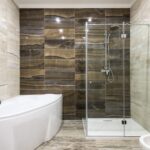
Making your home more accessible is not just about adding value; it’s about creating a space that welcomes everyone, regardless of their mobility or sensory needs. The essence of a truly inclusive home lies in its ability to adapt to different individuals, ensuring comfort, safety, and ease of navigation for all.
In cities like Charlotte, where the real estate market is witnessing significant growth—with home prices surging by 8.1% to a median of $400K last month—homeowners have a unique opportunity. By focusing on accessibility improvements, they can enhance their property’s appeal and functionality and address a crucial demand in today’s housing market.
In this article, we will look at some ideas to make your home more accessible.
Widen Doorways
The journey to a more accessible home begins with widening doorways. This seemingly simple modification can dramatically increase a home’s accessibility. Standard doorways might pose challenges for individuals using wheelchairs, walkers, or other mobility aids, making navigation through the house a challenging task.
By expanding doorways to at least 32 inches, preferably 36 inches, you ensure a smooth, barrier-free transition between spaces.
Installing Walk-In Showers for Enhanced Safety
The bathroom, with its inherent risk of slips and falls, demands particular attention in any discussion of accessibility. A key upgrade in this area is the installation of walk-in showers. These fixtures are designed to eliminate the need for stepping over a high tub wall, reducing the likelihood of accidents. Modern walk-in showers can be customized with safety features such as grab bars, non-slip flooring, built-in seating, and hand-held shower heads, making the bathing experience safer and more enjoyable for everyone.
In Charlotte, where the emphasis on stylish yet functional living spaces is growing, hiring a reliable Charlotte bathroom remodeling company to install a walk-in shower can be a smart move. They can offer expert advice on making your bathroom not only more accessible but also aesthetically pleasing, ensuring that it adds to the overall value and comfort of your home.
Install Ramps
Steps and stairs can be significant obstacles for individuals with mobility issues. Installing ramps is a practical solution for creating an accessible entrance to your home. Ramps provide a gentle incline, allowing for easy access for wheelchairs, scooters, and for anyone who finds stairs challenging to navigate.
When installing ramps, it’s important to adhere to the Americans with Disabilities Act (ADA) guidelines, which recommend a 1:12 slope ratio for ramps. This ensures safe and comfortable use. Moreover, ramps can be designed to blend seamlessly with your home’s exterior, enhancing its curb appeal while improving accessibility.
Improve Lighting
Proper lighting is a cornerstone of accessible design, vastly improving navigability and safety within a home. It is especially crucial for individuals with vision impairments but benefits everyone by reducing the risk of trips and falls.

Strategies for enhancing lighting include the installation of brighter, more energy-efficient bulbs, strategically placing lamps to illuminate walkways and common areas, and integrating motion sensor lighting for automatic illumination.
Additionally, ensuring that light switches are accessible—at a lower height for wheelchair users or as smart, voice-activated controls—can further enhance a home’s accessibility.
Leverage Smart Home Technology
Smart home technology has opened new doors to enhancing home accessibility. Innovations like voice-activated devices, automated lighting systems, and smart thermostats allow individuals with various disabilities to enjoy greater independence. Voice commands can control lights, lock doors, or adjust temperatures, eliminating the need for physical switches and thermostats that can be out of reach for some.
Smart home tech not only contributes to a safer, more accessible living environment but also adds a layer of convenience that benefits all residents, fostering an atmosphere where technology empowers everyone to live more comfortably.
Adjustable Countertops and Cabinetry
Adjustable countertops and cabinetry cater to the needs of individuals who might find standard kitchen setups challenging. With the touch of a button, countertops can lower to wheelchair height, or cabinets can descend to a more reachable level. This adaptability ensures that everyone, regardless of their physical abilities, can engage in cooking and cleaning activities, promoting independence and participation in daily life.
Integrating these features in a home not only meets a growing demand for inclusive design but also increases the property’s appeal to a broader audience.
Non-Slip Flooring
Flooring plays a crucial role in home safety and accessibility. Non-slip options are essential in preventing falls, particularly in areas prone to moisture, like bathrooms and kitchens. Textured vinyl, anti-slip tiles, or properly treated wood floors can provide the necessary grip underfoot, ensuring everyone, especially those with mobility issues, can confidently move through the house.
Opting for non-slip flooring materials is an investment in a home’s aesthetic and functional aspects. By creating a safer living environment, homeowners and visitors alike can enjoy peace of mind.
Accessible Outdoor Spaces
The importance of accessibility extends beyond the home’s interior to outdoor spaces. Smooth, level pathways allow for easy navigation around gardens and yards, while accessible garden beds and outdoor seating areas enable everyone to enjoy the beauty and tranquility of outdoor living.

For residents of Charlotte, where the temperate climate invites year-round outdoor activities, creating accessible outdoor spaces can significantly enhance the quality of life. These modifications make a home more inviting and encourage a connection with nature and the outdoors, which is beneficial for everyone’s mental and physical well-being.
Conclusion
Transforming a home into an accessible, inclusive space is more than just a series of renovations; it’s about embracing a philosophy that values comfort, safety, and independence for everyone. As we’ve explored through these eight ideas, from widening doorways to ensuring outdoor spaces are accessible, each modification brings us closer to creating environments where limitations are minimized, and inclusivity is the norm. For homeowners in Charlotte, investing in accessibility is not only a wise decision in a booming real estate market but also a commitment to a future where everyone, regardless of their physical abilities, can feel truly at home.
By considering the principles of accessible design, we enhance the immediate comfort and functionality of our homes and contribute to a more inclusive society.






